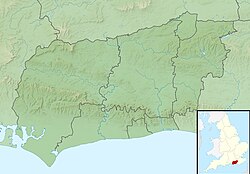History
In a violent storm of 13 November 1840, the brig Victoria was driven ashore at Littlehampton. A line was drifted ashore, and two Coastguard officers, along with their team of men, hauled a small boat out to the wreck three times, and saved the nine men aboard. On the same day, they also waded out into the surf with lines attached, and saved five men off the sloop Lively of Poole. Ever since its founding in 1824, the Royal National Institution for the Preservation of Life from Shipwreck (RNIPLS), later to become the RNLI in 1854, would award medals for deeds of gallantry at sea, even if no lifeboats were involved. Lt. Timothy Macnamara was awarded the RNIPLS Gold Medal, with Lt. George Davies receiving the RNIPLS Silver Medal. [4] [5] [6]
With lifeboats placed at Hayling Island, Bembridge and Selsey, in 1884, it was decided to close the station at Chichester Harbour, and create a new station at Littlehampton. A boathouse was constructed for £311-1s-7d, on a site provided by the War Department, on the east bank of the River Arun, near what is now the Harbour Park amusement park. [7] [8]
The 32-foot 'Pulling and Sailing' (P&S) lifeboat, one with oars and sails, the 19-year-old lifeboat James and Elizabeth was transferred from Chichester on 25 August 1884. The boat, manned by fishermen and local coastguard, was paraded around the town to the station, where she was renamed Undaunted. On station for only 4 years, she would be launched just twice, but was not required to rescue anyone. [8]
A new 34-foot lifeboat, James, Mercer and Elizabeth (ON 172), was placed at Littlehampton in 1888. On 2 November 1901, the lifeboat was launched to the aid of the brigantine Amy of Plymouth, on passage from Sunderland to Exeter with a cargo of coal, and now driven ashore. With extreme difficulty, the Littlehampton lifeboat got along side, and rescued the crew of six. In the poor conditions, the boat was beached at East Preston, and later returned to station on her carriage. This lifeboat would rescue 12 people in her 16 years on station. [8]
In 1903, the Coastguard site at Littlehampton was re-developed, and a row of terraced cottages were constructed along what became Coastguard road. The boathouse had to be moved, and was reconstructed at the end of the terrace, at the junction with Arun Parade, at a cost of £240. A new 35-foot lifeboat was placed at Littlehampton in 1904, provided from the legacy of Mr. Francis J. Freeman, of Abbey Road, St John's Wood, London, and named Brothers Freeman (ON 531). The boat would be launched 14 times in the next 17 years, and rescue 10 lives. [1] [8]
Following the retirement in November 1918 of Coxswain G. J. Pelham, who had served in this role since the station opened in 1884, and also Second (and latterly Acting) Coxswain Alonzo Allen in January 1919, Honorary Secretary Mr. Griffiths reported that no replacement officers were appointed to the lifeboat, and finding a crew was proving extremely difficult. Littlehampton lifeboat station was closed temporarily in February 1921. However, with a motor-lifeboat planned to be placed at Selsey in 1922, Littlehampton Lifeboat Station closed permanently on 5 December 1921. Brothers Freeman (ON 531) was withdrawn, and transferred to Plymouth. [7] [8] [9]
Reopening and Blue Peter appeals
Increased leisure boating in the area led to a corresponding rise in marine rescues, including swimmers and small craft washed out to sea, necessitating a faster local response. An Inshore lifeboat station was established at Littlehampton in 1967. The station operated a D-class (RFD PB16) lifeboat, housed in a garage on the east bank of the river Arun.
The cost was defrayed by a fundraising appeal on the BBC TV programme Blue Peter . The lifeboat was named Blue Peter I (D-115). The original Blue Peter I lifeboat would come to be replaced five times, with subsequent lifeboats being of the larger twin-engined Atlantic type. Funded each time by appeals on Blue Peter, each replacement lifeboat retained the name Blue Peter I until 2016. [11] [12] [13] [14]
For more information on Blue Peter lifeboats, please see:–
1979–present
In 1979, a new boathouse was built for the station near Fishermen's Quay, enabling quick launch down a short ramp into the River Arun. [9]
In 2002, the station underwent a large re-development to fit in with the recent waterside changes in the area. The new station has been designed specifically as a two-boat station at a cost of £550,000. At this time, the station was provided with a B-class (Atlantic 75) lifeboat, Blue Peter I (B-779), at a cost of £100,000. [14]
A new D-class (IB1) Inshore lifeboat, Spirit of Juniper (D-631), was donated by the Campaign for Real Gin in 2004, at a cost of £25,000, and served until 2014. She was replaced by Ray of Hope (D-769), a later version of the D-Class IB1, funded by a private donor at a cost of £42,000. [14] [15]
The final Blue Peter I was replaced in 2016 by a B-class (Atlantic 85) boat, Rennee Sherman (B-891). [16]
The Littlehampton lifeboat station was the busiest in the West Sussex area, with 61 call outs in 2020, and 913 between 2008 and 2020. [17]







